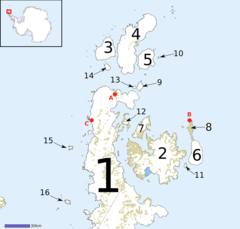| Hidden Lake Formation | |
|---|---|
| Stratigraphic range: Coniacian[1] | |
| Type | Geological formation |
| Unit of | Gustav Group |
| Underlies | Santa Marta Formation |
| Overlies | Whisky Bay Formation |
| Lithology | |
| Primary | Sandstone |
| Other | Siltstone |
| Location | |
| Coordinates | 63°00′S 57°00′W / 63.0°S 57.0°W |
| Approximate paleocoordinates | 63°06′S 63°54′W / 63.1°S 63.9°W |
| Region | James Ross Island, James Ross Island group |
| Country | Antarctica |
| Type section | |
| Named for | Hidden Lake |
 Map of James Ross Island group James Ross Island is number 2 | |
The Hidden Lake Formation is a Late Cretaceous geologic formation in Antarctica. The sandstones and siltstones of the formation were deposited in a deltaic environment.
Indeterminate megalosaur remains have been recovered from it.[2] Also many plant fossils and ichnofossils of Planolites sp. and Palaeophycus sp. have been found in the formation.[3]
- ^ Crame, J. A.; Pirrie, D.; Riding, J. B. (2006). "Mid-Cretaceous stratigraphy of the James Ross Basin, Antarctica". Geological Society, London, Special Publications. 258 (1): 7–19. Bibcode:2006GSLSP.258....7C. doi:10.1144/GSL.SP.2006.258.01.02. ISSN 0305-8719.
- ^ Weishampel, et al. (2004). "Dinosaur distribution" pp. 517–607. in Weishampel, David B.; Dodson, Peter; and Osmólska, Halszka (eds.): The Dinosauria, 2nd, Berkeley: University of California Press. 861 pp. ISBN 0-520-24209-2. " pp. 517–607.
- ^ Hidden Lake at Fossilworks.org